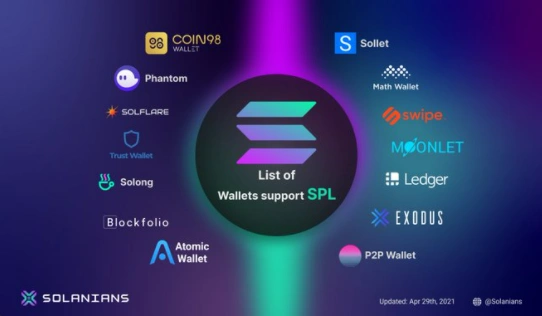Intro to Solana and Solana NFTs

Gas fees on the Ethereum blockchain have recently been a deterrent to new users trying to onboard to NFTs and Web 3.0. Paying hundreds of dollars just to purchase an NFT or swap coins is simply not feasible for mass adoption. As a result, users have started looking to other blockchains for a reprieve on fees. Below, we'll introduce the Solana blockchain and how you can get started exploring NFTs on Solana.
What is Solana?
Solana is a layer one blockchain built for scalable, user-friendly decentralized applications.
Initially released in 2019 by the Solana Foundation, the Solana blockchain has quickly risen to fame as a high-performance blockchain enabling fast transactions with low fees.
Much like users transact on the Ethereum blockchain with the native currency ETH, transacting on the Solana blockchain is done with SOL. Like BTC and ETH, SOL can be broken into smaller units known as lamports, named after the famed computer scientist Leslie Lamport. Users can acquire SOL with fiat currencies on a major cryptocurrency exchange like FTX.
The Solana blockchain's main objective is to allow fast speeds and low transaction costs for developers and users. At present time, Solana can handle 50,000 transactions per second, significantly higher than Ethereum, which is capped at 15 transactions per second (you read that right). Because Solana enables such fast transactions with small fees, it is widely viewed as the largest competitor and biggest rival to the Ethereum blockchain.
Can Solana Compete with Ethereum?
To onboard millions of new users to Web 3.0 and NFTs, making transactions fast and cheap is a major priority. Those without experience in cryptocurrencies are much more likely to be turned away by the excessive fees of each NFT they purchase on Ethereum. Solana provides an alternative to Ethereum in this regard, allowing users to create near-instant transactions with only a small fee.
Because of the congestion and demand on the Ethereum blockchain, most Ethereum transactions on the Ethereum blockchain today can require hundreds of dollars in fees depending on the type of transaction. On the other hand, the average cost of a transaction on the Solana blockchain is less than a penny (~$0.00025).
These lower fees provide end-users the ability to transact more without breaking the bank.
The maturation of the Solana ecosystem and continued expansion of applications for DeFI and NFTs has helped usher in a top-five market cap for the SOL token.
How Can You Get Started with Solana?
Like with Ethereum, interacting with the Solana blockchain and decentralized applications requires utilizing a wallet with blockchain compatibility. In the case of Ethereum, the most popular Web 3.0 wallet is MetaMask.
Some of the most commonly used wallets for holding SOL and Solana NFTs are Phantom, Solflare, and Sollet. Each of these wallets is accessible as a browser extension similar to MetaMask.
Editor's Note: Our Guide to Getting Started with Phantom is here.
To fund a wallet, users can first purchase SOL on a major cryptocurrency exchange. The SOL token is currently available on exchanges like FTX and Coinbase.
After purchasing the SOL token, users can send SOL from the exchange to their SOL wallet (Phantom or others).
Are Solana NFTs on OpenSea?
The Solana blockchain is currently not supported by the leading secondary NFT marketplace, Opensea. However, there are many other marketplaces available to trade Solana NFTs.
Some of the most commonly used marketplaces for collecting Solana NFTs are FTX, Solanart, Magic Eden, and SolSea.
Each of these marketplaces allows users to buy and sell NFTs that are being built on the Solana blockchain.
How do the Solana NFT Marketplaces Compare?
FTX
Though best known as a major cryptocurrency exchange, FTX has recently joined the fold offering trading of NFTs, primarily on the Solana blockchain. With FTX, users can buy, sell, and trade NFTs utilizing the exchange account they've created without requiring a self-custody wallet like Phantom or Sollet.
Solanart
Solanart was the first major NFT marketplace built on Solana. The site is currently in beta and has about 3,000-5,000 active users per day, with over $2M per day in trading volume. Solanart accepts eight different major wallet brands and features most of the big NFT projects that exist on Solana, like Degen Ape Academy. Solanart takes a 3% fee on sales, plus the fee chosen by the creators of their collection.
Magic Eden
Magic Eden has gained traction over the past few months and is currently the leading marketplace for trading Solana NFTs, thanks to no listing fees and only a 2% transaction fee. Magic Eden also allows users to make and cancel bid offers on NFTs for 0% fees. When you make an offer, the SOL leaves your wallet and is held in the Magic Eden escrow until it is accepted by the seller, or the offer is canceled, in which case the funds are returned. Bidding on Solana NFTs does require a minimum offer price of 50% of the item's listed price.
SolSea
SolSea is the first open NFT marketplace on Solana. Unlike competitors, Solsea enables creators to choose and embed licenses when they mint NFTs. Additionally, SolSea calculates rarity rank, score, and traits statistics for every fully minted, verified NFT collection. SolSea supports both FTX-Pay and self-custody wallets such as Phantom, Sollet, and Solflare.

